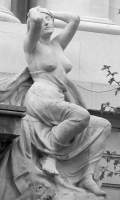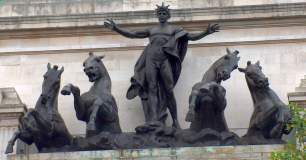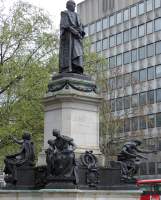
Flanking the entrance of Australia House in the Strand, London, are two large, pyramidal sculptural groups in stone: The Awakening of Australia and The Prosperity of Australia, by the Australian artist Harold Parker. Each group consists of a seated female figure at the top, with two heroically proportioned males seated or reclining below. They are of late date – 1915-18 – but satisfyingly allegorical.
The Awakening of Australia shows a semi-clad woman stretching from sleep, her eyes still shut, her hair bound in a piece of cloth as some sort of nightcap. She wears the light garments of sleep, with some heavier cast-off robe behind that suggests its use as a blanket. The two older, male figures below, unclad, show a man reading from a map, and seemingly the same man, perhaps tired from his exploring, seated apparently asleep, holding in one hand some stick or sword within the stone of the monument.
The Prosperity of Australia has the summit female figure holding a dove against her breast, perhaps recollecting the return of the dove to the ark, thus symbolising that a place of safety and plenty has been assured. Her other hand is outstretched, palm upwards, in a gesture of giving. The erect pose of her figure always puts me in mind of a work by that most successful of Australian sculptors, Bertram Mackennal, called For She Sitteth on a Seat in the High Places of the City.
Beneath her, are two youthful male figures – representing a new generation from the figures on the Awakening group - again unclad, the one cradling a fleece above a ram’s head which emerges from the stone, the other with sheafs of wheat – thus the two foundations of Australia’s prosperity at that time. The figure on the right is posed rather similarly to the Elgin Marble pedimental figure thought to represent Dionysus, with the legs, torso and arms and shoulders similarly placed. Another reclining male, similarly inspired if the pose is anything to go by, is the figure of Science on the Victoria Memorial. Yet Parker’s figures are not classical in their faces or musculature, but belong to a post-Edwardian semi-idealism combined with a realism to the faces of which these groups are a late example. But the Awakening girl stands out as something more iconic, a figure which could have sprung from the New Sculpture of ten or twenty years previously. Her upturned arms remind me of another figure of Awakening, on Chelsea Embankment, by Gilbert Ledward, dating (at least in the bronze version) from a little later.
We have already mentioned Bertram Mackennal, and high up above, is his work Phoebus driving the Horses of the Sun, with a bronze nude man with cloak and crown, arm raised, and the front halves of the four rearing horses from his chariot. Again, most appropriate for Australia. There is lots of work to see by Mackennal in London and elsewhere in England.
 Phoebus driving the Horses of the Sun, by Mackennal.
Phoebus driving the Horses of the Sun, by Mackennal.
We may note that as designed by the architects (A.M. and M.R. Mackenzie) in pre-WW1 drawings, while a galloping horses with central figure group was envisaged for the position above the grand corner portico, the side positions were anticipated to have single heroically scaled male figure statues; Harold Parker's groups as finally emplaced give rather a different accent to the entrance.
The entrance to Australia House faces onto the open space in front of St Clement Danes Church, and here is another sculptural group of major importance, the Gladstone Memorial by Hamo Thornycroft, with a standing figure of the great Prime Minister, and four allegorical groups, each of a woman and child. We may mention in passing two rather stiff military figures closer to the church – Lord Douding and Arthur Harris, modern works by Faith Winter. To the right as we look at Australia Awakening is the LSE building on Aldwych, with architectural sculpture by Albert Hodge, and these and other work on Aldwych are described on this page. Further interesting architectural sculpture is to be found along the Strand, towards Trafalgar Square, and in older work in the monuments of the church of St Dunstan’s in the West. Alternatively, eastwards brings us to Fleet Street and the City.
Finally, we might add that for those interested in Australian subject matter, this site includes a note on the monument to the first Governor of Australia, the Sir Arthur Phillip Monument, Watling Street.
 The Gladstone Memorial, Strand.
The Gladstone Memorial, Strand.
This page was originally part of a 'sculpture of the month' series, for May 2012. Although the older pages in that series have been absorbed within the site, if you would wish to follow the original monthly series, then jump to the next month (June 2012) or the previous month (April 2012). To continue, go to the bottom of each page where a paragraph like this one allows you to continue to follow the monthly links.
Sculpture along the Strand // Gladstone Monument // Sculpture in Fleet Street
Sculptors // Sculpture in London
Visits to this page from 13 Mar 2014: 2,406 since 11 February 2024